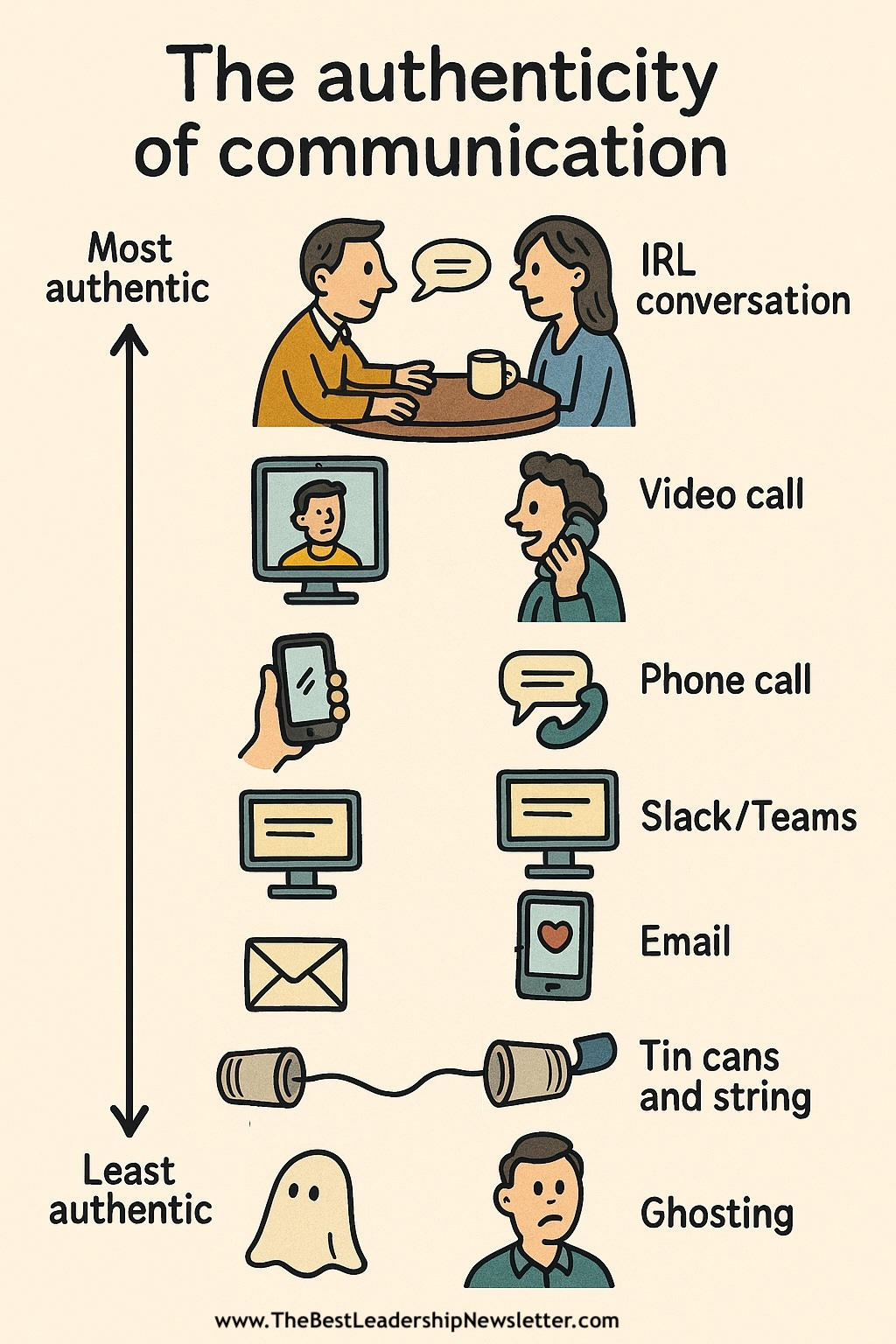336. Your Communication Process Is Your Communication Problem
You can’t expect to improve your company’s communication problem without altering the company’s communication processes.
This is The Best Leadership Newsletter Ever, the most fun way to learn life’s leadership lessons.
My name is Jeff Matlow. I am a coach. I help leaders and their teams solve big problems fast. Learn how to sleep better at night
I don’t remember your question, but the answer is “better communication.”
That’s the answer for most workplace problems. In fact, a whopping 86% of all failures at work are due to communication problems.
Nutso, right?
If only you were a better communicator.
Now, hold on… Don’t get your panties in a bunch quite yet.
I’m not about to give you the same old lecture about the importance of transparency and active listening. Let’s not pretend that a simple article is going to have any lasting impact on your communication skills.
It won’t.
[Editor’s Note: you’d be better off with a well-known coach, like this one]
Instead of talking about your communication *behavior*, today we’re going to talk about your communication *processes*. Because if you’re anything like the companies I consult, you’ve got a wee bit of work to do in that arena.
The Communication Problem And The Communication Process
If you know me, my articles or podcasts, you’ve no doubt heard me preach about how a company’s leadership behavior is inextricably linked to the company’s products and processes.
Your current business processes are a direct result of your current leadership behavior.
[This is known as Conway’s Law, and it’s a real thing. You should read about it here.]
If you want to improve a team’s behavior, you also have to improve their processes - or else nothing much will change.
You can’t expect to improve your company’s communication problem without altering the company’s communication processes.
No matter how amazing you think you are at communicating, ineffective processes will decrease morale, destroy productivity, and reduce retention.
Your crappy communication processes will kill your company culture.
Boom. Dead.
When Good Communication Meets Bad Communication Process
When people are having productivity problems with their teams, they hire me. That’s my job. So I see this situation a lot.
Sometimes the problem is behavior-related, sometimes it’s a process problem, but usually it’s both.
Every now and then, I’m brought in by a leadership team that has pretty decent communication skills, but pretty crappy communication processes.
In other words, their teams are respectful of each other, open to different ideas, and focused on growth - but the method in which they communicate is broken.
Is your company the same? Here’s how to tell:
Are you continually late on delivering interdepartmental projects?
Is there a Grand Canyon-like gap in alignment between department leaders?
If so, you probably have problems with your communication processes.
As I said, I’m paid to fix these problems. But because I like you, I’m going to give you a simple solution for the low, low price of free.
I gotchoo, baby.
The Chaotic Free-For-All of Communication Problems
It’s easy to communicate when you’ve got a team of two. It’s not even that terrible with a team of ten.
But once you get beyond a team of 25 employees, things begin to become a smidge more complicated.
Suddenly, there’s hierarchy. There are strategic leaders and hands-on doers. There are people who have different ideas of how to do their different jobs, and they all want to feel empowered to do it their own way.
Without conscious guidance, communication can become a chaotic free-for-all.
You’ll have some people who rely on Slack, Teams, Zoom, Google, email, or text. There are those people who want to use the telephone and others who always want to meet in person. There are CRMs, bug tracking, and project management platforms that become required tools for relevant departments. And then there are the locked-lipped few who just want to do their work and not talk to anybody at all. Ever. (raise your hand if that’s you)
The result of communication spread across so many channels is… well, communication problems.
How many times have you sworn you sent out a notification, but you just can’t remember what damn platform you sent it on?
I’ve been there. I see you.
When there are so many ways to communicate, it’s sometimes easier not to communicate at all.
And therein lies the problem:
Most companies have the resources and ability to communicate - they just don’t have the processes to do it efficiently.
How To Determine If Your Communication Processes Is The Communication Problem
Does your company have poor communication processes? Here’s a test:
Ask five employees at different levels how they communicate when they have to alert others to a time-sensitive topic.
If they all answer differently - or if they start their response with the words, “it depends” - then your company’s got a communication problem.
There’s an easy solution, though.
Here it is.
How To Set Company Communication Protocols
The best communicating companies are the ones with clear communication protocols. Your protocols start by answering these questions:
What are the different types of communication that happen at your company?
What is the primary platform to be used for most, if not all, of those communication types?
What are the other communication platforms used for?
What are the expected response times for each type of communication?
How do you communicate if there is something urgent?
What system do you use for difficult conversations?
What system do you use for brainstorms?
This may sound daunting. It may sound like I’m asking you to remember a complex communication flowchart.
I’m not.
Once you answer the questions above, you’ll realize it’s not that complicated at all. Let me show you.
The Different Types Of Company Communication
The first task in solving your communication problems is to list the different types of communication you have at your company. Here’s a sample list to get you started (feel free to add whatever I’ve missed):
Casual / team banter
Internal project updates
External client updates
Cross-departmental decisions
Technology errors and feedback
Difficult conversations
Crisis or time-sensitive needs
Brainstorms
Once you’ve outlined the types of conversations, the next step is to choose the primary and secondary channels of communication for each of them.
Hint: Your primary channel should remain as consistent as possible across the conversation types - and be able to integrate with your other communication platforms. Most companies use Slack or Teams as their primary channel. I prefer Slack. But that’s me.
Here’s a sample list of conversations and channels.
See how easy this is?
Now that you have the types of conversations and the channels to use, you just need to set response time expectations. For instance:
Slack: within 4 business hours
Email: within 1 business day
Calls: same day (if scheduled or urgent)
Text: 1 hour or less, but only if someone or something is on fire (metaphorically or literally). Otherwise, 1 business day.
It’s important to understand that a “response” is different than a resolution. A “response” may mean acknowledging the communication, which could be something like “I’m sorry, I’m crushed with a deadline, I’ll respond tomorrow.”
Promoting The Protocol To Solve The Communication Problem
Getting the protocol in place is critical to scale your company and department. But creating the protocol isn’t enough - now you have to implement it.
Make it part of the onboarding process
Reinforce it in team meetings.
Leaders must strictly model and enforce it — “use the damn thread, bucko.”
Here’s a little thing that always seems to work: Break communication platforms down into:
✅ “When to use this”
❌ “When NOT to use this”
Your Communication Problem, Solved
If your communication process is a mess, your culture will eventually be, too.
Not because your people don’t care.
Not because your team isn’t talented.
But because they’re getting too frustrated with inconsistencies in communication, and wondering why they can’t just get the damn answer to their quick question that’s now delaying the entire project.
It doesn’t matter how inspiring your all-hands was or the assortment of snacks in the kitchen — if no one knows where, how, or when to talk to each other, things will fall apart.
So here’s your job:
Build the protocol.
Teach the protocol.
Follow the damn protocol.
Because remember:
It’s not just about what you say — it’s about how and where you say it.
If you like this post, please share it on LinkedIn 🙏🏽👊🏼
Want to submit a leadership topic?
Is there a leadership topic you want advice on?
Is there a co-worker/colleague you need help interacting with?
Share your idea(s) in the comments or email me directly.
Subscribe to The Best Leadership Podcast Ever
YouTube
Apple
Spotify
or your favorite podcast player.









Oh, I really enjoy your writing style!!! 🤗
Really like this, Jeff. You make a strong case for process. I’d add that tools and process go hand in hand; the tools of communication (clarity, presence, empathy) come first, and once those are in place, the process keeps everything moving. Both matter.